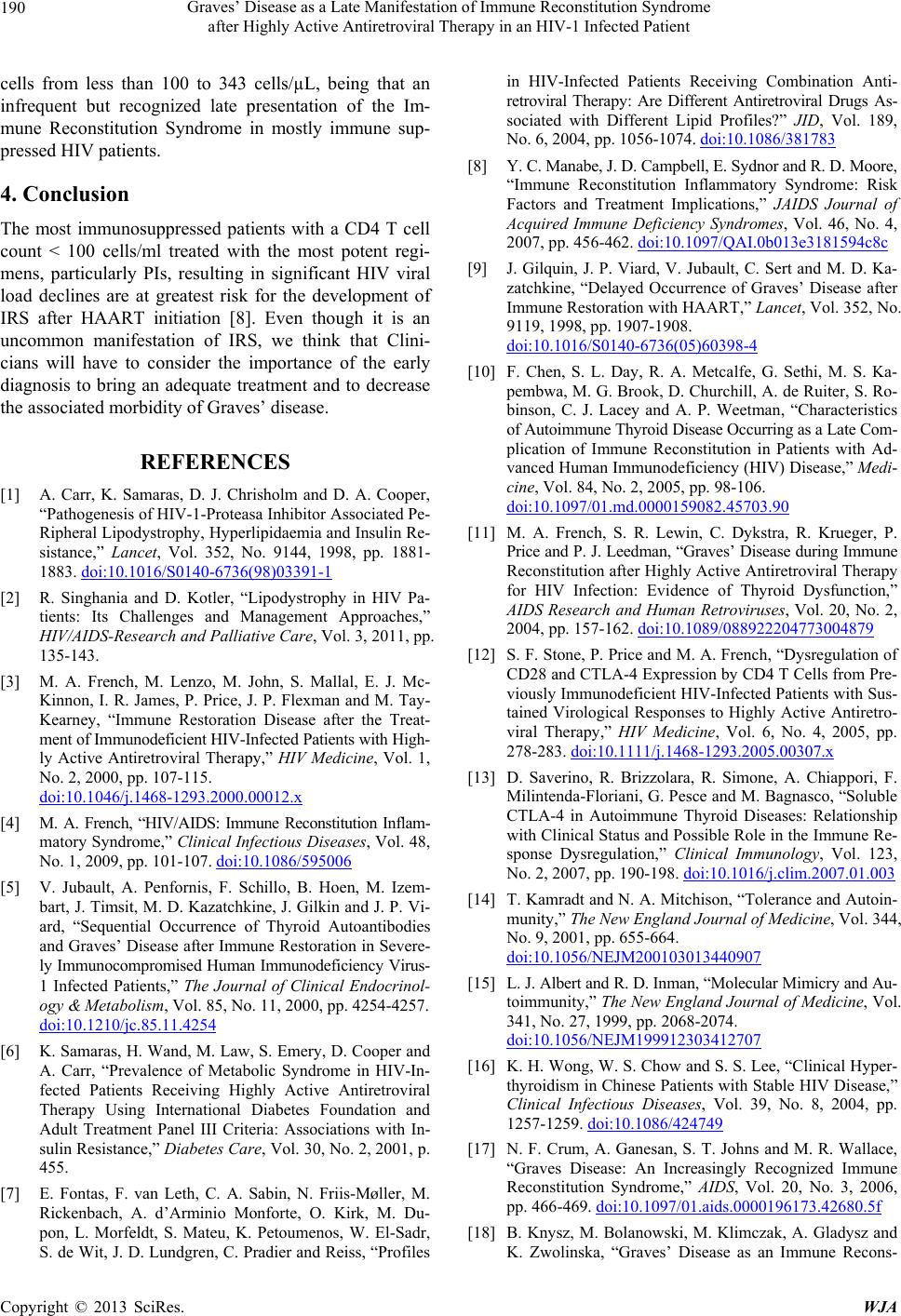
Graves’ Disease as a Late Manifestation of Immune Reconstitution Syndrome
after Highly Active Antiretroviral Therapy in an HIV-1 Infected Patient
190
cells from less than 100 to 343 cells/µL, being that an
infrequent but recognized late presentation of the Im-
mune Reconstitution Syndrome in mostly immune sup-
pressed HIV patients.
4. Conclusion
The most immunosuppressed patients with a CD4 T cell
count < 100 cells/ml treated with the most potent regi-
mens, particularly PIs, resulting in significant HIV viral
load declines are at greatest risk for the development of
IRS after HAART initiation [8]. Even though it is an
uncommon manifestation of IRS, we think that Clini-
cians will have to consider the importance of the early
diagnosis to bring an adequate treatment and to decrease
the associated morbidity of Graves’ disease.
REFERENCES
[1] A. Carr, K. Samaras, D. J. Chrisholm and D. A. Cooper,
“Pathogenesis of HIV-1-Proteasa Inhibitor Associated Pe-
Ripheral Lipodystrophy, Hyperlipidaemia and Insulin Re-
sistance,” Lancet, Vol. 352, No. 9144, 1998, pp. 1881-
1883. doi:10.1016/S0140-6736(98)03391-1
[2] R. Singhania and D. Kotler, “Lipodystrophy in HIV Pa-
tients: Its Challenges and Management Approaches,”
HIV/AIDS-Research and Palliative Care, Vol. 3, 2011, pp.
135-143.
[3] M. A. French, M. Lenzo, M. John, S. Mallal, E. J. Mc-
Kinnon, I. R. James, P. Price, J. P. Flexman and M. Tay-
Kearney, “Immune Restoration Disease after the Treat-
ment of Immunodeficient HIV-Infected Patients with High-
ly Active Antiretroviral Therapy,” HIV Medicine, Vol. 1,
No. 2, 2000, pp. 107-115.
doi:10.1046/j.1468-1293.2000.00012.x
[4] M. A. French, “HIV/AIDS: Immune Reconstitution Inflam-
matory Syndrome,” Clinical Infectious Diseases, Vol. 48,
No. 1, 2009, pp. 101-107. doi:10.1086/595006
[5] V. Jubault, A. Penfornis, F. Schillo, B. Hoen, M. Izem-
bart, J. Timsit, M. D. Kazatchkine, J. Gilkin and J. P. Vi-
ard, “Sequential Occurrence of Thyroid Autoantibodies
and Graves’ Disease after Immune Restoration in Severe-
ly Immuno compromise d Human Immunode ficiency Vi rus-
1 Infected Patients,” The Journal of Clinical Endocrinol-
ogy & Metabolism, Vol. 85, No. 11, 2000, pp. 4254-4257.
doi:10.1210/jc.85.11.4254
[6] K. Samara s, H. Wand, M. Law, S. Emery, D. Cooper and
A. Carr, “Prevalence of Metabolic Syndrome in HIV-In-
fected Patients Receiving Highly Active Antiretroviral
Therapy Using International Diabetes Foundation and
Adult Treatment Panel III Criteria: Associations with In-
sulin Resistance,” Diabetes Care, Vol. 30, No. 2, 2001, p.
455.
[7] E. Fontas, F. van Leth, C. A. Sabin, N. Friis-Møller, M.
Rickenbach, A. d’Arminio Monforte, O. Kirk, M. Du-
pon, L. Morfeldt, S. Mateu, K. Petoumenos, W. El-Sadr,
S. de Wit, J. D. Lundgren, C. Pradier and Reiss, “Profiles
in HIV-Infected Patients Receiving Combination Anti-
retroviral Therapy: Are Different Antiretroviral Drugs As-
sociated with Different Lipid Profiles?” JID, Vol. 189,
No. 6, 2004, pp. 1056-1074. doi:10.1086/381783
[8] Y. C. Manabe, J. D. Campbell, E. Sydnor and R. D. Moore,
“Immune Reconstitution Inflammatory Syndrome: Risk
Factors and Treatment Implications,” JAIDS Journal of
Acquired Immune Deficiency Syndromes, Vol. 46, No. 4,
2007, pp. 456-462. doi:10.1097/QAI.0b013e3181594c8c
[9] J. Gilquin, J. P. Viard, V. Jubault, C. Sert and M. D. Ka-
zatchkine, “Delayed Occurrence of Graves’ Disease after
Immune Restoration with HAART,” Lancet, Vol. 352, No.
9119, 1998, pp. 1907-1908.
doi:10.1016/S0140-6736(05)60398-4
[10] F. Chen, S. L. Day, R. A. Metcalfe, G. Sethi, M. S. Ka-
pembwa, M. G. Brook, D. Churchill, A. de Ruiter, S. Ro-
binson, C. J. Lacey and A. P. Weetman, “Characteristics
of Autoimmune Thyroid Disease Occurring as a Late Com-
plication of Immune Reconstitution in Patients with Ad-
vanced Human Immunodeficiency (HIV) Disease,” Medi-
cine, Vol. 84, No. 2, 2005, pp. 98-106.
doi:10.1097/01.md.0000159082.45703.90
[11] M. A. French, S. R. Lewin, C. Dykstra, R. Krueger, P.
Price and P. J. Leedman, “Graves’ Disease during Immune
Reconstitution after Highly Active Antiretroviral Therapy
for HIV Infection: Evidence of Thyroid Dysfunction,”
AIDS Research and Human Retroviruses, Vol. 20, No. 2,
2004, pp. 157-162. doi:10.1089/088922204773004879
[12] S. F. Stone, P. Price and M. A. French, “Dy sregulation of
CD28 and CTLA-4 Expression by CD4 T Cells from Pre-
viously Immunodeficient HIV-Infected Patients with Sus-
tained Virological Responses to Highly Active Antiretro-
viral Therapy,” HIV Medicine, Vol. 6, No. 4, 2005, pp.
278-283. doi:10.1111/j.1468-1293.2005.00307.x
[13] D. Saverino, R. Brizzolara, R. Simone, A. Chiappori, F.
Milintenda-Floriani, G. Pesce and M. Bagnasco, “Soluble
CTLA-4 in Autoimmune Thyroid Diseases: Relationship
with Clinical Status and Possible Role in the Immune Re-
sponse Dysregulation,” Clinical Immunology, Vol. 123,
No. 2, 2007, pp. 190-198. doi:10.1016/j.clim.2007.01.003
[14] T. Kamradt and N. A. Mitchison, “Tolerance and Autoin-
munity,” The New England Journal of Medicine, Vol. 344,
No. 9, 2001, pp. 655-664.
doi:10.1056/NEJM200103013440907
[15] L. J. Albert and R. D. Inma n, “Molecular Mi micry and Au-
toimmunity,” The New England Journal of Medicine, Vol.
341, No. 27, 1999, pp. 2068-2074.
doi:10.1056/NEJM199912303412707
[16] K. H. Wong, W. S. Chow and S. S. Lee, “Clinical Hyper-
thyroidism in Chinese Patients with Stable HIV Disease,”
Clinical Infectious Diseases, Vol. 39, No. 8, 2004, pp.
1257-1259. doi:10.1086/424749
[17] N. F. Crum, A. Ganesan, S. T. Johns and M. R. Wallace,
“Graves Disease: An Increasingly Recognized Immune
Reconstitution Syndrome,” AIDS, Vol. 20, No. 3, 2006,
pp. 466-469. doi:10.1097/01.aids.0000196173.42680.5f
[18] B. Knysz, M. Bolanowski, M. Klimczak, A. Gladysz and
K. Zwolinska, “Graves’ Disease as an Immune Recons-
Copyright © 2013 SciRes. WJA